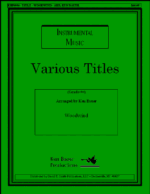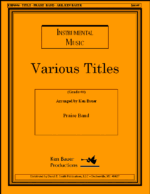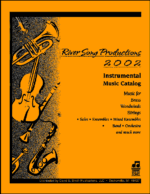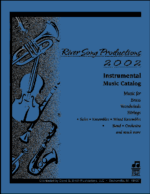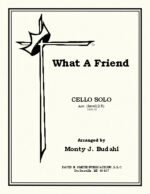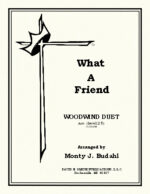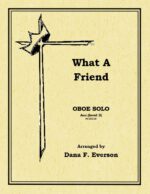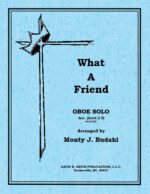-
What A Friend We Have In Jesus
$16.95This standard is designed for mixed instruments (trumpet, alto sax, trombone & piano… bass part if needed) crafted for smaller groups yet provides a full and satisfying sound.
-
What A Friend We Have In Jesus
$30.00Perfect for offertories, recessionals, youth gatherings and concerts, this ballad may be performed with as few as 4 players (Trp, A. Sx, Tbn, Pno) yet expands to include a full band (3 Trp, 2 A. Sx, T. Sx, Bari Sx, 3 Tbn, Pno, Bass, Gtr, Organ)
-
-
-
What A Friend
$4.00A solo that begins with a brief introduction in the piano. The soloists then presents the tune in a straight-forward rendition. The second section presents the tune in the piano while the soloist overlays with a gentle obligato. The third section goes back to the melody briefly and then shifts back to the obligato and then settles into a final repose.
-
What A Friend
$4.00A solo that begins with a brief introduction in the piano. The soloists then presents the tune in a straight-forward rendition. The second section presents the tune in the piano while the soloist overlays with a gentle obligato. The third section goes back to the melody briefly and then shifts back to the obligato and then settles into a final repose.
-
What A Friend
$5.00An unaccompanied brass duet for trumpet and trombone (opt. Horn) This pieces uses subtle imitative devices and moving counterpoint between the parts. It ends with a sense of quiet confidence.
-
What A Friend
$5.00A duet for clarinet and saxophone that begins with a brief introduction in the piano. The clarinet then presents the tune in a straight-forward rendition with the saxophone supporting with a moving harmonization ending with a melodic line. The second section presents the tune in the saxophone while the clarinet overlays with a gentle obligato. The third section goes back to the structure of the beginning briefly and then shifts back to the obligato addition and then settles into a final repose.
-
What A Friend
$5.00A duet for flute and clarinet that begins with a brief introduction in the piano. The flute then presents the tune in a straight-forward rendition with the clarinet supporting with a moving harmonization ending with a melodic line. The second section presents the tune in the claeint while the flute overlays with a gentle obligato. The third section goes back to the structure of the beginning briefly and then shifts back to the obligato addition and then settles into a final repose.
-
What A Friend
$9.00Scored for Saxophone quartet (A-A-T-B) with opt. Soprano for first Alto. The introduction starts with the First Alto playing a melodic motif, ever rising to a climatic point and then settling down to the theme- first presented in the First and Tenor parts weaving in and out producing a flowing texture, then joined by the Second Alto and eventually the Baritone. The chorus section of the hymn is a constant weaving of the four parts both harmonically and rhythmically. The next section becomes more active rhythmically adding tension until it settles down into a sweet aura of sound with gentle nudges of harmonic alteration. The final measures give an atmosphere of rest and solace.
-
What A Friend
$4.50This solo begins with a polite introduction and then is joined with the soloist in a gentle alteration of the tune in its entirety. A second verse is modulated upward with the tune with even more variation. After more modulations there is a brief cadenza and then a coda section based on the opening motif of the tune.
-
What A Friend
$4.50This solo begins with a polite introduction and then is joined with the soloist in a gentle alteration of the tune in its entirety. A second verse is modulated upward with the tune with even more variation. After more modulations there is a brief cadenza and then a coda section based on the opening motif of the tune.
-
What A Friend
$4.50This solo begins with a polite introduction and then is joined with the soloist in a gentle alteration of the tune in its entirety. A second verse is modulated upward with the tune with even more variation. After more modulations there is a brief cadenza and then a coda section based on the opening motif of the tune.
-
What A Friend
$4.00A solo that begins with a brief introduction in the piano. The soloists then presents the tune in a straight-forward rendition. The second section presents the tune in the piano while the soloist overlays with a gentle obligato. The third section goes back to the melody briefly and then shifts back to the obligato and then settles into a final repose.
-
What A Friend
$4.50This solo begins with a polite introduction and then is joined with the soloist in a gentle alteration of the tune in its entirety. A second verse is modulated upward with the tune with even more variation. After more modulations there is a brief cadenza and then a coda section based on the opening motif of the tune.
-
What A Friend
$4.00A solo that begins with a brief introduction in the piano. The soloists then presents the tune in a straight-forward rendition. The second section presents the tune in the piano while the soloist overlays with a gentle obligato. The third section goes back to the melody briefly and then shifts back to the obligato and then settles into a final repose.
-
What A Friend
$4.50This solo begins with a polite introduction and then is joined with the soloist in a gentle alteration of the tune in its entirety. A second verse is modulated upward with the tune with even more variation. After more modulations there is a brief cadenza and then a coda section based on the opening motif of the tune.

